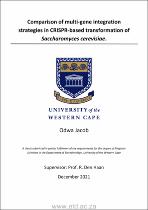| dc.description.abstract | Saccharomyces cerevisiae is an important host in industrial biotechnology. This yeast is the host of choice for the first and second-generation biofuels for ethanol production. Genome modification in S. cerevisiae has been extremely successful largely due to this yeast’s highly efficient homology-directed DNA repair machinery. The advent of CRISPR (Clustered Regularly Interspaced Short Palindromic Repeats) genome editing technology has made multi-gene editing in yeast more accessible. In this study, we aimed at targeting the Cas9 to multiple genomic positions for integrating multiple genes at different sites. We have developed two CRISPR-Cas9 systems, based on published one- and two-plasmid systems, for application in S. cerevisiae strains. In this study, these CRISPR-Cas9 systems were used to transform fungal heterologous genes into yeast using the electroporation transformation method. We first utilized the CRISPR systems for targeting the T.r.eg2 gene to single locus chromosomal sites for single copy integration. Subsequently, we then targeted the same gene to repeated sequences in the genome, namely the delta sites, for multi-copy integration. The procedure was repeated with a different gene, T.e.cbh1, integrated into the same sites to ascertain reporter gene specific effects. High integration efficiency was achieved, since all the strains successfully integrated the genes. However, we discovered significant differences in enzyme activities between the two genes when targeted to different loci, as well as varying copy numbers as determined by qPCR. The T.e.cbh1 gene was highly expressed by yeast transformants targeted at the repeated delta sequences used for multi-copy integration, reaching maximum levels of 248 mU/gDCW. The T.r.eg2 gene was highly expressed in yeast transformants targeted to the single locus site on chromosome 12, reaching a maximum of 160U/gDCW, though it was shown that off-target integration likely occurred. We then used the information from these observations to construct a CBP yeast strain containing three cellulase genes: T.r.eg2, T.e.cbh1, and S.f.BGL1. Significant differences in enzyme activities were observed between the three genes, and it was shown that the S.f.BGL1 gene was poorly expressed by the CBP yeast strain, whereas the T.r.eg2 gene was highly expressed. Notably, due to the fact that marker containing plasmids could be cured from these strains, many additional genetic changes can still be made. Overall, our two CRISPR-Cas9 systems were efficient at engineering strains that produce recombinant proteins and can be used in future studies for a variety of applications, including metabolic engineering in S. cerevisiae | en_US |

